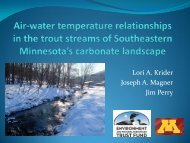Minnesota Water Resources Conference - Water Resources Center ...
Minnesota Water Resources Conference - Water Resources Center ...
Minnesota Water Resources Conference - Water Resources Center ...
Create successful ePaper yourself
Turn your PDF publications into a flip-book with our unique Google optimized e-Paper software.
Concurrent Sessions V 1:15–2:45<br />
Track C: Education/Planning<br />
BOOK OF ABSTRACTS<br />
Wednesday, Tuesday, October 24 28 23<br />
Engaging Diverse Groups in Environmental Education: a Case Study of the Hmong Community in<br />
<strong>Minnesota</strong><br />
Jenny Winkelman, Mississippi <strong>Water</strong>shed Management Organization, jwinkleman@mwmo.org; Katherine Barton, Barton and<br />
Associates; Foung Heu, Digital Motion, LLC<br />
Nonpoint source pollution continues to be the major cause of pollution in United States waterways. Pollution<br />
prevention efforts in <strong>Minnesota</strong> still rely primarily on written materials, usually in English, and distributed<br />
in conventional ways. This information is not accessible nor designed to be relevant to increasingly diverse<br />
populations.<br />
In 2005, the Mississippi <strong>Water</strong>shed Management Organization and the City of Minneapolis piloted a study in the<br />
Hmong community to increase the effectiveness and reach of pollution prevention efforts. The Hmong comprise<br />
a large, established community in <strong>Minnesota</strong> forced to flee Laos after the Vietnam War.<br />
Knowledge of water issues, the cultural context for water and communication preferences were identified<br />
through focus groups, in-depth interviews and a phone survey (conducted in Hmong). The resulting water<br />
education plan focuses on three major outcomes: building community leadership and capacity, increasing<br />
environmental literacy and stewardship actions, and modeling best practices for education in diverse<br />
communities.<br />
Low Impact Design (LID) as a Shaping Element in the Urban Planning Process: A Case Study of the 46 th<br />
and Hiawatha Transit-Oriented Development Strategy, Minneapolis, MN<br />
Timothy Gross, Three Rivers Park District, tgross@threeriversparkdistrict.org; Mark Nolan, Plan4<br />
The 46th & Hiawatha Transit Oriented Development (TOD) Strategy has elevated urban planning standards<br />
by incorporating sustainable and high performance infrastructure as a fundamental element of urban design.<br />
The purpose of this study was to develop and define strategic infrastructure, policy and development tools to<br />
be used for shaping the 46th Street and Hiawatha Avenue light-rail transit station area into a neighborhood<br />
that could fully embrace a multi-modal lifestyle. Beyond just a competing demand that must be considered,<br />
this planning study purposefully used the planning process to examine need; review function and form; win<br />
public and regulatory support; and influence policy and funding mechanisms to stimulate and encourage LID<br />
improvements.<br />
The objectives of this presentation are to highlight methodologies and strategies used in the 46 th & Hiawatha TOD<br />
Strategy and to provide a framework for future planning studies to shape and influence the use of LID as an inherent<br />
component of the urban fabric. Conclusions and recommendations stemming from this process include:<br />
1. Policies affecting the appropriate implementation of LID need to be done on the planning level, not the<br />
design level.<br />
2. Effective stormwater management is site specific; from both a functional and socio-economic perspective.<br />
3. Sustainable infrastructure and economic development incentives can work together.<br />
4. Public and private involvement in the LID analysis and implementation process can change the perception<br />
of LID from an occasional stormwater management tool, to a standard practice.<br />
<strong>Minnesota</strong> <strong>Water</strong> <strong>Resources</strong> <strong>Conference</strong>, October 27–28, 2008 70
















